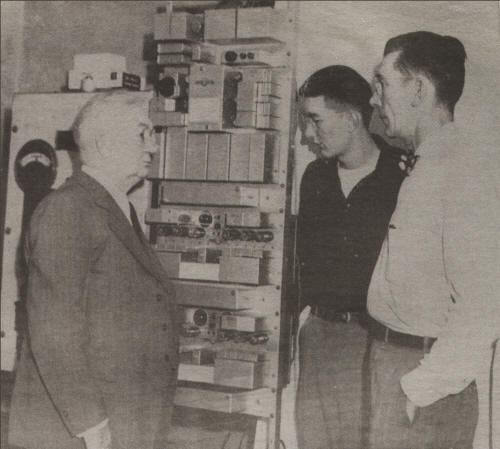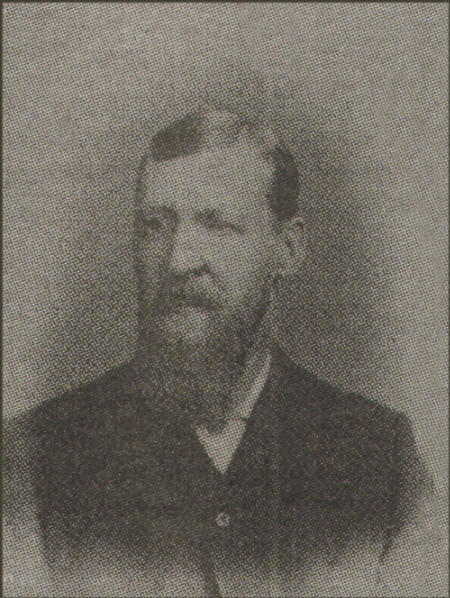|
|
|
Clark County Press, Neillsville, WI January 24, 1996, Page 21 Transcribed by Dolores (Mohr) Kenyon. Index of "Oldies" Articles |
|
|
|
Clark County Press, Neillsville, WI January 24, 1996, Page 21 Transcribed by Dolores (Mohr) Kenyon. Index of "Oldies" Articles |
Good Old Days
By Dee Zimmerman
Early Northern Clark County Telephone Systems
Dr. H. H. Christofferson of Loyal was responsible for the first efforts given to the telephone business in northeastern Clark County.
The main difficulty or handicap in the doctor’s medical practice was to reach his rural patients on time, especially the maternity cases. At that time, babies were delivered in the home. The father would ride a horse into town to summon the doctor. Too much time lapsed in the process which delayed the doctor’s arrival, much to the doctor’s annoyance.
Christofferson realized the trouble was with the communications, not with the doctor’s speed. He voiced his annoyance to other residents in the town until someone came up with the suggestion of a better and faster way – one lone telephone on the end of a line from Neillsville. That telephone, Loyal’s only means of talking with the outside world, was located in the office of A. A. Graves sawmills, used for logging business calls. It was only one telephone, but it worked, and phones like it were beginning to work all over the country.
What if the farmers out around Loyal had telephones and what if then they could call into Loyal for the doctor and for other purposes? That was the question Dr. Christofferson put to Mike Doyle, first president of the Citizens State Bank, and together they set out to find the answer. They interested some farmers in the first rural lines. The arrangement was that the farmers were to dig the holes and set the poles. Then the company strung the wires and made connections to the homes.
The doctor’s race with time began in 1900, when Christofferson came to Loyal, just out of medical school. By 1905, lines from Loyal ran to Granton, Spencer, Spokeville and Coxy’s Camp. Two years later the organizations headed by Doyle and Christofferson bought the primary exchange which had been started by business of Loyal. That exchange consisted of 15 stations. Added to the farm lines, this really put the Doyle – Christofferson organization into business.
That was the approximate period of telephone development in neighboring communities. A man named Hanson ran a line from Curtiss to Withee, and at Colby, Charles Carlton and S. E. Danes gave the business a start. Abbotsford also got its first small exchange. Owen, relatively new, was progressing, and J. L. Clarke gave it telephone service, also extending a line to Withee.
Early in 1911, Karl Mess bought the Colby property and encouraged Fred J. Schwierske of Wittenberg to move here, (to) help with the project. As Schwierske stated later he “came with a toothbrush and night shirt, but stayed to raise a family.”
Up to this time the telephone business in the eastern and northern part of the county was amateurish and rudimentary. The small individual exchanges were too small to be commercially attractive. So Dr. Christofferson conceived the idea of combining exchanges, and organized the Clark County Telephone Co. for that purpose. This concern purchased the Colby exchange in 1912, with the understanding that Schwierske went along as part of the transaction. Then the Clark County Co. took over the Beaver Telephone Co., which was owned by farmers and a switch board was installed in the office of Dr. Fred Soles in Spencer, with Mrs. Soles in charge. Four years later, Abbotsford joined and in 1918 the properties of Owen, Withee and Curtiss were added. At that time about 200 stations were in service in and around Owen.
After organizing this group, the Clark County Telephone Co. made improvements. Grounded lines were metallicized by the addition of another wire, and a common battery switchboard and telephones were installed in Owen in 1920. A one-story building was constructed in Colby and upon its completion the common battery service was introduced.
Not all of the troubles of the early telephone service were due to primitive equipment, as Dr. Christofferson learned. In the days of the central being located at a second floor location in Colby, a subscriber complained to the Doctor that he had been unable to raise an answer from central at a time of need during the night. Schwierske found nothing wrong with the equipment. The doctor decided to check on the central night worker, a man, the next evening as he returned from a patient call and heard the telephone bell ringing. He walked up the stairs and looking through the window, saw the fellow sleeping. Rather than rattle the door, Christofferson walked down the stairs, picked up a slab of fire wood and tossed it through the window. The operator was awakened in more ways than one.
Obviously, Christofferson had fun with establishing the telephone business and once it was well into operation, he had succeeded in his purpose, being able to reach his emergency calls quicker. So, approached in 1927 by representatives of the State Telephone Co., he sold, and the Clark County Telephone Co. became part of the organization, which in turn joined the consolidated Telephone Co. in 1928, and that soon was taken over by Commonwealth. That company in 1930 converted Spencer to automatic dial equipment.
How well Christofferson succeeded in securing an even break with emergency calls was indicated by the fact that the Clark County Telephone Co. had over 1,000 phones in service when he went out of the telephone business. Fifteen years later, the Commonwealth had 1,544 telephones in Clark County. Those were served from five exchanges – Colby, Abbotsford, Spencer, Owen and Loyal. At that time, the first three were under the management of Fred. J. Schwierske, with head quarters at Colby, and the last two were managed by L. J. Doucette, head quartered in Owen.
Badger State Telephone & Telegraph – Southern Clark County
H. H. Heath took over management of the organization known as the Badger State Telephone of Mauston in 1898. The Neillsville property was sold in 1901 to a corporation known as Badger State Telephone & Telegraph Co. Fred Runkel was a business partner with Heath when it was sold to William L. Smith and Joseph C. Marsh, of Marshfield in 1903.
Smith’s affiliation with the telephone business extended for many years, enough that it qualified him to head the Wisconsin pioneers of the independent telephone industry in 1945.
When Smith entered the telephone business in 1903 the Neillsville exchange had about 150 phones nearly all of them in Neillsville. There were three rural lines. One went to Greenwood, with a small switchboard in a drug store, and with a wire branching off eastward to Romadka and Granton, and a small switchboard in the Knoor & Rausch hardware store at Granton; another rural line running out of the Youmans farm (Later known as the Paulson farm), a third, remnant of the old Black River Improvement line, running to Day Corners. Day Corners was on south side of the highway 73 and 95 Junction, a cheese factory was located there.
Herbert Smith, son of William, started working with the Badger State Telephone Co. in 1921, eventually becoming manager as his father eased out of business in the late 40’s, early 50’s. Herb was with the business form 1921, other than his military service form Oct. 1940 through Apr. 1944, until 1965 when, as owner, he sold the company and retired.
The old Black River Improvement Co. had an instrument in the Peterson store at Greenwood, this early connection of the Petersons with the telephone led eventually to the organization of the Greenwood Telephone Co., with P. E. Peterson as the leader.
The telephone business in Thorp originated with James Connor, who ran a saloon, where the bank building was built, later, as the telephone exchange was in a little wooden building behind it. Connor was also deputy sheriff at that time. Those who knew him said, “He made it go, every job he took on.”
The Thorp business was incorporated as the Thorp Telephone Co. in 1905, and was operated by the Myron Lund Family until 1938. At that time it went into the hands of L. O. Bernhagen. At the time Bernhagen took over there were 173 telephones in the exchange. In seven years the number grew to 412, with pressure for installations beyond the capacity to fill them, results from the rapid development at that point in time.
As Herb Smith said, “We saw many changes in the telephone industry from 1921 to 1965 … and since then, there have been so many more.”
 |
William L. Smith, on the left, with his grandson, Jerry, and son, Herbert, are shown observing what was then a modern invention in 1953 whereby four messages could travel over a circuit previously confined to one message. That year was also the fiftieth anniversary of Wm. L. Smith’s association with the Badger State Telephone & Telegraph Co. business in Clark County.
In the beginning, Smith’s primary effort was to apply to the service the public standard of need and demand. The result was a great extension of service, with a range of calls without tolls over 220 sections of land for the Badger system and about 88 sections for the Lynn Telephone Co., for which Badger did the switching. The 1953 number of subscribers was 1,650.
His son, Herb, joined the company in 1921 and eventually took over the business. Herb retired and sold the Badger Telephone system in 1965.
 |
Mr. Nesbitt was manager of the Black River Improvement Co. It was his duty to oversee the maintenance of the two dams to direct the impounding of water to float logs downstream to the saw mills and to collect tolls on the logs. The Improvement Co. built the first telephone line in Clark County, running it along Black River. Its original use was in the management of the business, and especially in giving orders for starting the log drives.
|
© Every submission is protected by the Digital Millennium Copyright Act of 1998.
Show your appreciation of this freely provided information by not copying it to any other site without our permission.
Become a Clark County History Buff
|
|
A site created and
maintained by the Clark County History Buffs
Webmasters: Leon Konieczny, Tanya Paschke, Janet & Stan Schwarze, James W. Sternitzky,
|